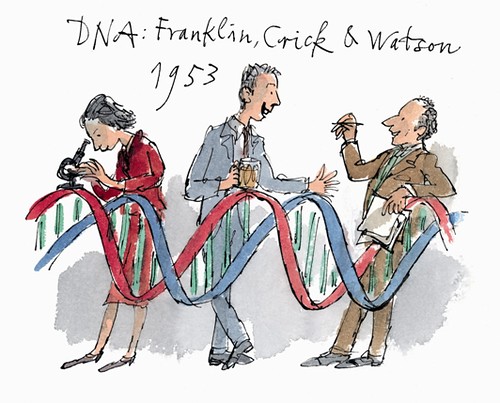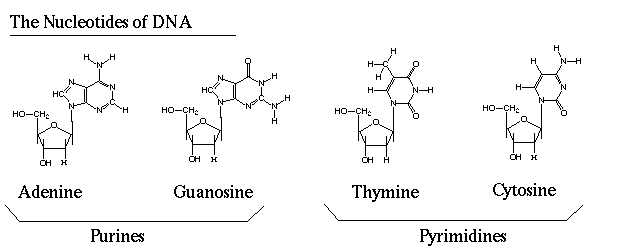Francis Harry Compton Crick was born June 8th, 1986. James Dewey Watson was born on April 6th, 1928.
 |
| James Watson (left) and Francis Crick (right) |
 |
| Cartoon of Francis Crick and James Watson |
They were partners, and they discovered the DNA (deoxyribonucleic acid) double-helix.
 |
| Double-Helix |
FUN FACT: The first time Francis Crick and James Watson tried to build the DNA structure, it didn't work.
FUN FACT: Francis Crick has a brother, who is a doctor in New Zealand. He was going to get his Ph.D, but the war interrupted him.
FUN FACT: James Watson wrote several papers on the construction of the virus. He likes bird watching, and he has never married.
Next up, Severo Ochoa. He's got a cool name. Severo Ochoa was born on September 24th, 1905. He's a bit older than Francis and James, but it's fine. Severo Ochoa contributed to genetics with the genetic code. The genetic code is 64 triplets of nucleotides. Nucleotides form the basic structural units of nucleic acids, like DNA.
FUN FACT: Francis Crick has a brother, who is a doctor in New Zealand. He was going to get his Ph.D, but the war interrupted him.
FUN FACT: James Watson wrote several papers on the construction of the virus. He likes bird watching, and he has never married.
Next up, Severo Ochoa. He's got a cool name. Severo Ochoa was born on September 24th, 1905. He's a bit older than Francis and James, but it's fine. Severo Ochoa contributed to genetics with the genetic code. The genetic code is 64 triplets of nucleotides. Nucleotides form the basic structural units of nucleic acids, like DNA.
 |
| The Nucleotides of DNA |
Anyway, the triplets are called codons. In 1931, Severo married Carmen Garcia Cobian. He died November 1st, 1993.
FUN FACT: Seveo Ochoa was a Hispanic scientist, and the youngest of seven children.
FUN FACT: Seveo Ochoa was a Hispanic scientist, and the youngest of seven children.
 |
| Severo Ochoa |
Last but not least (because she's a girl), Barbara McClintock. Now, in my opinion, she's the best, but not because she's a girl or anything, and that makes her superior, but because...well, she's a girl, and that makes her superior. It makes her superior, not only because she's a girl, but because science was thought to be beyond woman's abilities, even though woman had a lot to do with some of it, like the discoverer of radioactivity Barbara McClintock was born June 6th, 1902. Her contribution to genetics was the genetic transposition. She also helped us a little in understanding chromosome structure.
 |
| Young Barbara McClintock |
 |
| Old Barbara McClintock |
Um, if you wanna know, genetic transposition is 'the ability of genes to change positions on chromosomes, in which a transposable element is removed from one site and inserted into a second site in the DNA'. I got that definition at http://www.medterms.com/. Anyway, Barbara McClintock died on September 2nd, 1992.
FUN FACT: Barbara McClintock began her interest in genetics when she was an undergraduate.
FUN FACT: Barbara McClintock began her interest in genetics when she was an undergraduate.
So, out of the four people we talked about today, one is still alive. That's kinda sad. I hope you enjoyed, and I ask you guys for no haters...on any of my classmate's bogs. Okay? Good. Speaking of my classmate's blogs, if you wanna know/learn more, please go to their blogs. As always, the links are below. Stay tuned!
SuperSara's Blog
youngro-jalenguy's blog
Katie's Blog
Kevin's Blog
SuperSara's Blog
youngro-jalenguy's blog
Katie's Blog
Kevin's Blog
















